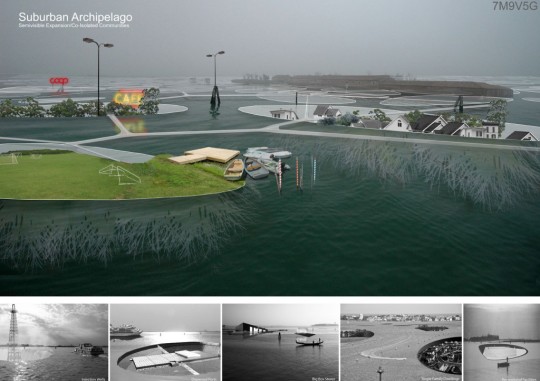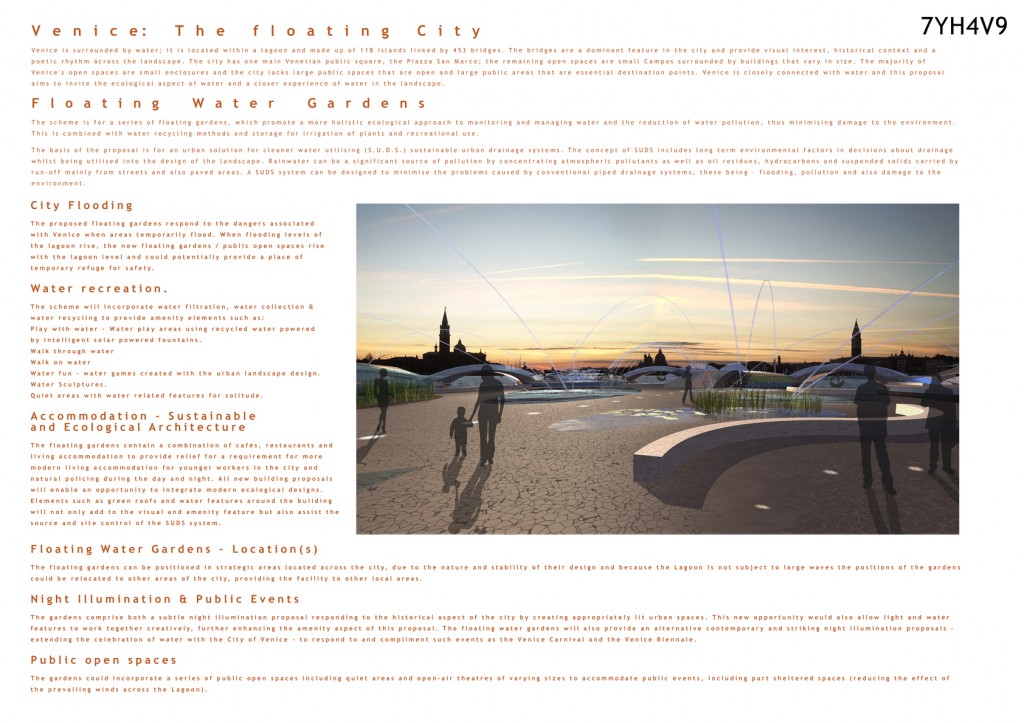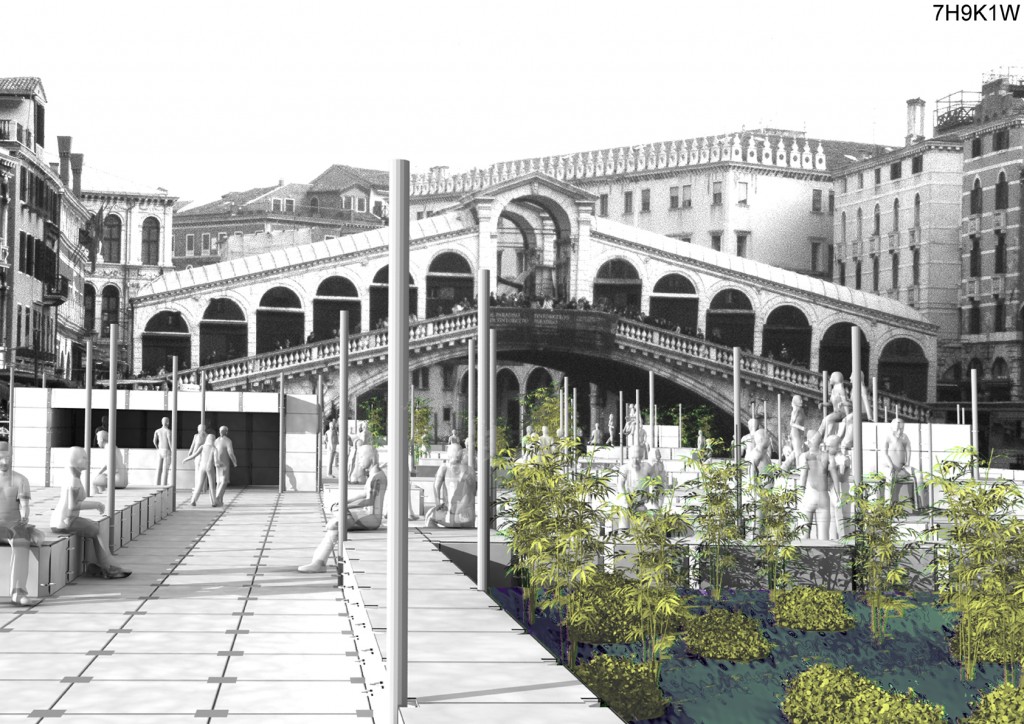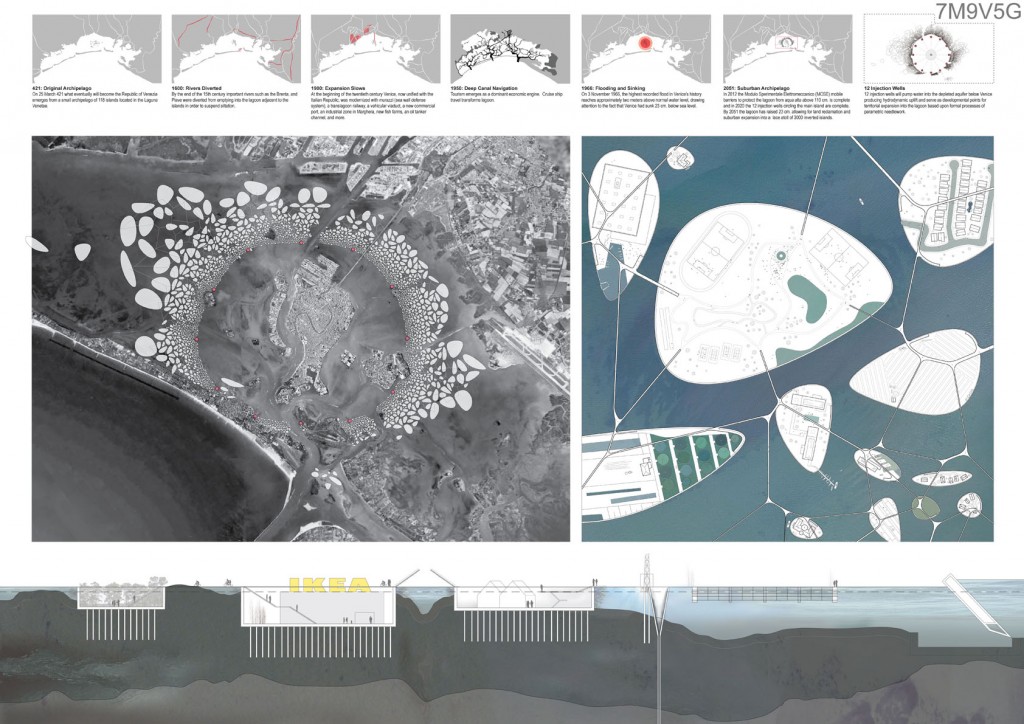Info:
Title: Suburban Archipelago - Code: 7M9V5GContest: Venice / 2011
By: B. Boberska / A. Hovsepyan / E. W. Olsen / Dr. P. Singley
Views: 3634 Likes: 1
Votes:
BJARKE INGELS11 NERI OXMAN8 ELENA MANFERDINI3 MARIA LUDOVICA TRAMONTIN5 BOSTJAN VUGA46.2
Suburban Archipelago

Suburban Archipelago: Semivisible Expansion/Co-Isolated Communities …nature and society are two perfectly happy bedfellows whose opposition is a farce. –Bruno Latour Yet, eighty percent of the population of Venice left – as we read – left towards the world of cars, highways, pollution, supermarkets, tall apartment buildings, that is, towards the “real life” – as lived today. And they left behind the dreamy Venice, abandoning her to the swarming tourists. –ICARCH Gallery, ”A House For Marinetti – In Venice”
Bruno Latour’s observation that the opposition between nature and society is false epitomizes Venice, Italy. Having been born from a loose archipelago of mud flats and salt marshes to emerge as La Serenissima, the Queen of the Adriatic, Venice is a completely artificial construct naturally placed into an equally artificial lagoon. From the Renaissance diverting of rivers to prevent the lagoon from silting up to the more recent construction of MOSE (Modulo Sperimentale Elettromeccanico) to withhold high tides above 110 centimeters, Venice continues to rely upon infrastructural alchemy in order to maintain its mask of easy virtue.
As a way of reanimating and repopulating Venice’s islands, this project proposes another artificial transformation of the lagoon in the form of a slightly submerged archipelago that contains those suburban activities normally sequestered from the historical center. Suburban Archipelago will define new territory by expanding Venice’s growth into the lagoon while simultaneously providing dispersed thresholds through which tourists will dock and enter the city. The new archipelago emerges around the anchor points of twelve injection wells that, in the span of a decade, will lift the entire lagoon six inches through the pumping of water into the depleted aquifer.
When precisely did Venice stop growing and transform from a Republic of 175,000 citizens into a shrinking ghetto of 60,000 inhabitants that experiences annual inundation from approximately fifteen million tourists? Suburban Archipelago interprets the reciprocal inversion between the height of aqua alta and diminished tourist activity, the time when Venice returns to the Venetians, as a temporarily advantageous tidal shift that describes a submerged condition as favorable to local inhabitants. Indeed, the archipelago’s tidal fluctuations of appearing and disappearing every six hours delineate a nautical cartography the key to which remains known only to those initiated in the lagoon’s new topography.
Suburban Archipelago proposes to liberate Venice’s episodic growth into an obscured system of low-lying islands that provide both Venetians and tourists with an array of activities and housing typologies not available in the historic center. The archipelago will grow according to the following seven logics.
- 110 Centimeter Lagoon Height
The MOSE project will hold the Adriatic Sea back from the lagoon at a height of 110 centimeters for a sustained amount of time.
- Hydrodynamic Uplift
Twelve injection wells will pump water back into the aquifer, supporting a hydrodynamic uplift of the entire lagoon floor for an amount of six inches in a period of ten years.
- Parametric Needlework
The injection wells serve as developmental points for territorial expansion into the lagoon based upon formal processes of parametric needlework.
- Global and Local
The discreet lagoon islands interconnect by a network of circulation systems rendering them as both isolated and continuous entities that engage both local and global building patterns of fisheries or farms and big box stores or cul-de-sac housing.
- A-picturesque Planning
Suburban Archipelago proposes to include all activities that have been expelled from the historical city, due to their resistance to picturesque patterning, and exported to the suburbs. Their location in the lagoon gives them greater accessibility and consequently utility to the island Venetians.
- Redensification
Rather than mitigating tourism at a single entry point, such as proposed for Tessera, Suburban Archipelago will disperse tourist activity across a series of nodal access points located between Mestre and the Lido, Jesolo and Chioggia.
- Eco-technologies
While eco-technologies attached to each island will provide filtration systems to cleanse the lagoon and promote marine life, the islands themselves will serve as a conceptual breakwater against the large wakes of cruise ships, which undermine building foundations, that now dock at new locations. Algae harvesting will provide alternative fuel sources.
Suburban Archipelago recognizes that tensions between preservationist and progressivist politics render any solution for reviving the city unworkable, or at least paradoxical, to the extent that these constituent groups simultaneously delineate a need for expansion without change, regeneration without transformation, or growth without pain.
This project thus develops Peter Sloterdijk’s idea of “co-isolation” into a tensegrity of closed spline cells that together form an array of individual bubbles barely touching each other across the Venetian lagoon. While each island or bubble remains separate from its neighbor, the fact that they share space in the liquid solution of the lagoon also joins them together. Communication between the cells occurs through a network of systems, of vaporetti, traghetti, bridges, boats, and airwaves that rendering the project as isolated yet connected—co-isolated.
The desire is to develop an expansive foam atoll, returning Venice to its initial state of an archipelago, producing a series of self-contradictory worlds in which interior and exterior, global and regional, open and closed, local and tourist, natural and artificial provoke intentional misreadings of the spatial condition developed within this new, heterotopic development. It also returns Venice to its role as a furtive city, one where secret destinations remain hidden from any formal cartographic system.
Related Posts :
Comments:
Info:
Title: Suburban Archipelago
Time: 7 giugno 2011
Category: Venice
Views: 3634 Likes: 1
Tags: Adriatic Sea , Bruno Latour , Jesolo , MOSE Project , Peter Sloterdijk , Republic of Venice , Venetian Lagoon , Venice







